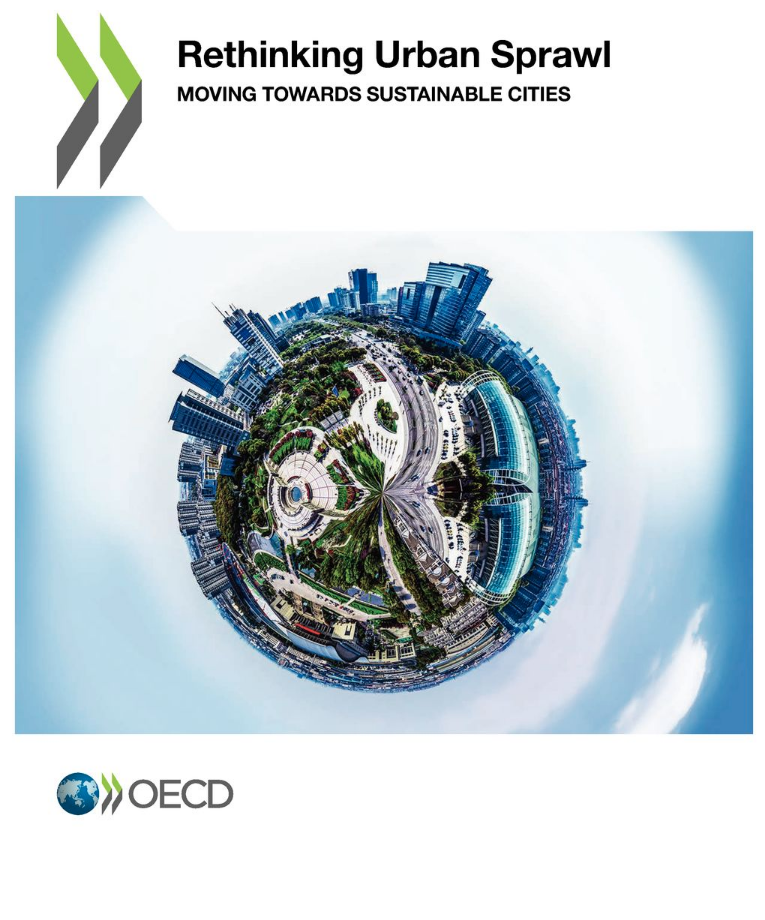OECD cities are increasingly fragmented and more people are moving to low-density suburbs. A new set of urban sprawl indicators applied in 1,156 urban areas in 29 counties at three points in time show that the share of urban land allocated to low population density areas continues to increase. However, patterns are not uniform across countries.
Cities in Austria, Canada, Slovenia, and the United States rank relatively high in multiple dimensions of sprawl, while cities in Denmark, France, and several Central European countries have sprawled along most of the dimensions examined over the period considered, 1990 to 2014. Separately, some cities in Greece, Ireland, Spain, Sweden, and the United Kingdom exemplify how suburbanization can coexist with densification, where average population density has been observed alongside growth in the percentage of urban land containing areas of very low density.
Enlarge

Moving Towards Sustainable Cities
DOI:http://dx.doi.org/10.1787/9789264189881-en
This report provides a new perspective to the nature of urban sprawl and its causes and environmental, social and economic consequences.
OECD
These insights are drawn from an assessment using seven indicators on the different dimensions of urban sprawl, outlined in a new OECD report, Rethinking Urban Sprawl Moving Towards Sustainable Cities. Data on average population density, population-to-density allocation, land-to-density allocation, valuation of urban population density, fragmentation, polycentricity, and decentralization capture the idea that urban sprawl can exist in urban areas where average population density is relatively high, if those areas contain large amounts of land where density is very low, as well as in cities that are discontinuous, scattered and decentralized.
The report dives deep into the multi-dimensional concept of urban sprawl, exploring its causes and consequences, setting the foundation for the development of this new set of indicators to measure, monitor, and compare urban sprawl across cities over time, and outlining policy options for more sustainable urban development.
Causes and consequences of urban sprawl
Demographic, economic, geographic, social, technological, and policy factors all contribute to urban sprawl – the urban development pattern characterized by low population density. These drivers range from preferences for living in low density areas, land-use regulations, progress in car manufacturing, low motor fuel taxes, to other policies encouraging car use.
Living in low density or dispersed urban areas has environmental, social, and economic impacts. As sprawled development patterns place more distance between daily destinations, environmental consequences include higher air pollution and greenhouse gas emissions from road transport, and loss of space and environmental amenities, as human intervention in a series of key environmental processes will likely affect water quality and increase flood risk. On the other hand, socio-economic consequences include higher per-user costs to provide primary public services such as water supply, sanitation, electricity, public transport, waste management, policing, and other services that are key for well-being.
A more sustainable path for urban development
Updating land use and transportation policies can help cities get back on a more sustainable track for urban development. In terms of land use policy, reforming regulations and property taxation are two essential pieces of the puzzle in achieving socially desirable levels of population density and reducing urban fragmentation. Relaxing maximum density restrictions, reforming urban containment policies, streamlining land-use taxation, reforming property taxation, and shifting the cost of infrastructure provision to developers are some of the land use policies that can be employed here.
To achieve sustainable urban development, policies are also needed to green transport systems and shift travel demand towards public and non-motorized transport, thereby encouraging less car-dependent cities and mitigating some of the environmental and socio-economic consequences of urban sprawl. Actions should focus on the introduction of road pricing mechanisms, reform of parking policies, alignment of motor fuel taxes with the external costs of fuel consumption, and investment in more sustainable forms of transport infrastructure.
Read the full OECD report, Rethinking Urban Sprawl Moving Towards Sustainable Cities.






